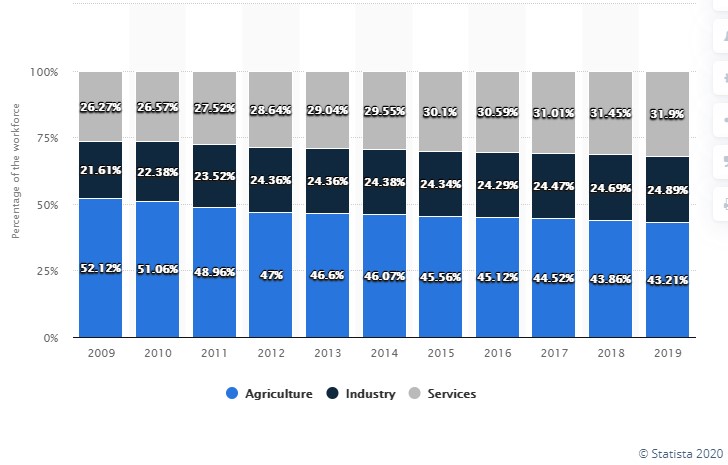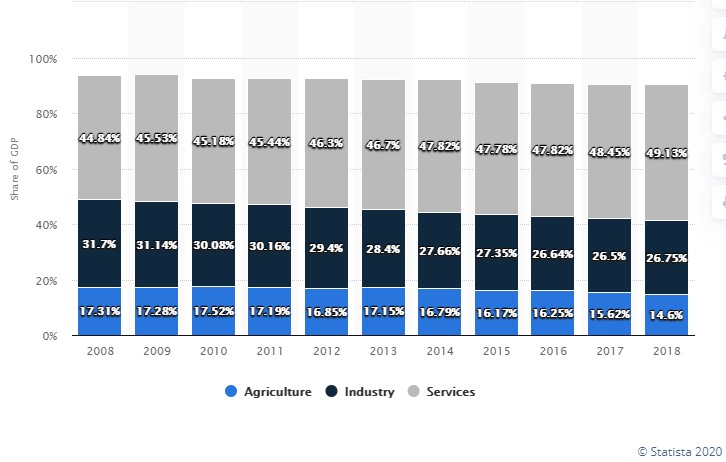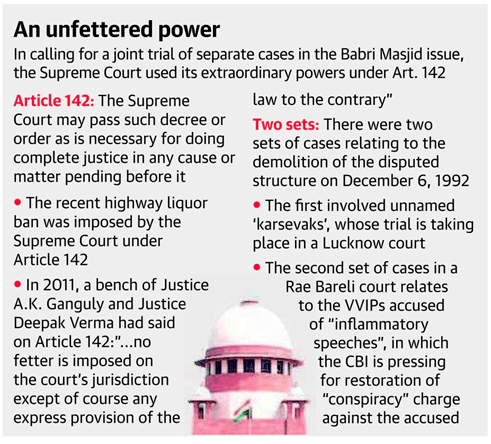Contents
- India’s unemployment rate dropped: CMIE
- Right to religion: Supreme Court explains
- No increase in lease rent of SEZ units
- Bond yields rise as govt. expands borrowing plan
- SC sets up panel to look into J&K Internet curbs
- Enzyme makes men vulnerable to COVID
- Mandis linked to e-NAM see 65% rise
INDIA’S UNEMPLOYMENT RATE DROPPED: CMIE
Focus: GS-III Indian Economy, Prelims (Don’t Focus too much on exact numbers)
Why in news?
India’s unemployment rate dropped to 23.97% on May 10 from 27.11% on May 3, as the government lifted some curbs on economic activity, including farming, after a month-long lockdown.
Unemployment Rate Survey results:
Urban
- The urban jobless rate, on the other hand, declined more modestly, underlining the fact that cities are still struggling to recover as covid-19 cases continue to rise.
- Urban unemployment declined to 27.83% in on 10 May from 29.22% on 3 May. However, the figure is still higher than the national job-loss rate of 23.97% and the rural job loss rate of 22.35%, according to CMIE.
- The job loss and wage loss in cities in both the formal and informal segments is negating whatever little activity is taking place in urban centres and industrial clusters.
Rural
- Rural unemployment rate declined four percentage points, indicating some farming activity has resumed during the harvest season.
- The rural economy, which accounts for the largest share of the workforce, also saw a fall in the unemployment rate to 22.35% in the week to 10 May from 26.16% in the previous week, according to CMIE data.
- However, some concerns exist that the rural unemployment rate may increase as millions of migrants stranded in cities make their way back to their home states.
Employment in the Indian Economy
- In 2012, there were around 487 million workers in India, the second largest after China.
- In 2018 reports show: Close to 81% of all employed persons in India make a living by working in the informal sector, with only 6.5% in the formal sector and 0.8% in the household sector.
- Among the five South Asian countries, informalisation of labour is the highest in India and Nepal (90.7%), with Bangladesh (48.9%), Sri Lanka (60.6%) and Pakistan (77.6%) doing much better on this front.
- Over 94 percent of India’s working population is part of the unorganised sector.
- Employment in India is multifaceted. There are people who are permanently unemployed; and there are people who are temporarily employed or temporarily unemployed (known as seasonal unemployment/employment), and in addition there is disguised unemployment – which in simple terms is the condition where a task that requires only 5 workers to handle it, is being handled by 12 workers.
- Agriculture, dairy, horticulture and related occupations alone employ 43 percent of labour in India. However, Agriculture and the allied sectors contribute only to 14.6% of India’s GDP!


-Source: Livemint
RIGHT TO RELIGION: SUPREME COURT EXPLAINS
Focus: GS-III Polity, Governance, Social Justice, Prelims
Why in news?
A nine-judge Bench of the Supreme Court declared that superior courts enjoy untrammeled power to take up any cause to do complete justice – three months ago, decided to go ahead and examine “larger issues” of religious freedom across multiple faiths in connection with the Sabarimala review.
Background: Entry of women
- Supreme Court’s original Sabarimala judgment of 2018, which allowed women of every age to enter and worship at the temple was to be reviewed by Supreme Court in 2019 (Which didn’t happen).
- However, “larger issues” concerning essential religious practices of various religions and clubbed other pending cases on subjects as varied as female genital mutilation among Dawoodi Bohras to entry of Parsi women who married inter-faith into the fire temple and Muslim women into mosques etc., were all referred to a larger bench.
- Hence the question arose as to how a Bench sitting in a limited review jurisdiction assumed powers to frame new questions of law?
Now: Dismissed Objections
There is no fetter on the exercise of discretion of this court in referring questions of law to a larger Bench in review petitions. Being a superior court of record, it is for this court to consider whether any matter falls within its jurisdiction or not.
It invoked Article 142 of the Constitution “which enables this court to make any order as is necessary for doing complete justice in any cause or matter pending before it.”

-Source: The Hindu
NO INCREASE IN LEASE RENT OF SEZ UNITS
Focus: GS-III Indian Economy, Prelims
Why in news?
The government on 11th May said the lease rent for units in the government-owned Special Economic Zones (SEZs) will not be increased for 2020-21 due to the COVID-19 pandemic.
This move which will provide relief to these facilities in SEZ.
Details
- The commerce and industry ministry said that after consulting the proposal with Department of Expenditure, these relief measures were decided for SEZ units on account of Covid-19 outbreak.
- It asked development commissioners of other SEZs to advise SEZ developers of state governments and privately-owned zones to consider similar relief measures.
- There are seven government-owned SEZs in the country and are under the supervision of a development commissioner (DC).
SEZ
- A special economic zone (SEZ) is an area in which the business and trade laws are different from the rest of the country.
- SEZs are located within a country’s national borders, and their aims include increased trade balance, employment, increased investment, job creation and effective administration.
- To encourage businesses to set up in the zone, financial policies are introduced.
- These policies typically encompass investing, taxation, trading, quotas, customs and labour regulations.
- Additionally, companies may be offered tax holidays, where upon establishing themselves in a zone, they are granted a period of lower taxation.
SEZ Policy in India
India was one of the first in Asia to recognize the effectiveness of the Export Processing Zone (EPZ) model in promoting exports, with Asia’s first EPZ set up in Kandla in 1965.
The Special Economic Zones (SEZs) policy was launched in April, 2000. The Special Economic Zones Act, 2005, was passed by Parliament in May, 2005
The salient features of the SEZ scheme are:
- A designated duty-free enclave to be treated as a territory outside the customs territory of India for the purpose of authorized operations in the SEZ
- No License required for import;
- Manufacturing or service activities allowed;
- The Unit shall achieve Positive Net Foreign Exchange to be calculated cumulatively for a period of five years from the commencement of production;
- Domestic sales subject to full customs duty and import policy in force;
- SEZ units will have freedom for subcontracting;
- No routine examination by customs authorities of export/import cargo;
- SEZ Developers /Co-Developers and Units enjoy Direct Tax and Indirect Tax benefits as prescribed in the SEZs Act, 2005.
-Source: Economic Times
BOND YIELDS RISE AS GOVT. EXPANDS BORROWING PLAN
Focus: GS-III Indian Economy, Prelims
Why in news?
- The yield on the most-traded 10-year government bond spiked 20 bps (basis points) on 11th May 2020, after the government announced it would increase its market borrowings by more than ₹4 lakh crore for FY21.
- Intraday, yield rose 27 bps, the sharpest intraday surge since February 2017.
- As per the new revised FY21 borrowing calendar, the central government will now borrow ₹6 lakh crore in the first half of the current financial year against the ₹4.88 lakh crore budgeted initially.
- Until RBI announces open market operations (OMO) to purchase government securities to address the supply glut, there would be pressure on yields.
What are Bonds?
- A bond is like an IOU. The issuer of a bond promises to pay back a fixed amount of money every year until the expiry of the term, at which point the issuer returns the principal amount to the buyer.
- When a government issues such a bond it is called a sovereign bond.
- Governments issue bonds as part of their borrowing programme.
- By purchasing a debt instrument like bond, an investor becomes a creditor to the corporation (or government).
- A bond is a financial security issued by a borrower to avail long term funds.
- Thus a bond is like a loan: the holder of the bond is the lender (creditor), the issuer of the bond is the borrower (debtor). The primary advantage of being a creditor (by purchasing bonds) is that he has a higher claim on assets than shareholders do. That means, in the case of bankruptcy, a bondholder will get his money back before a shareholder.
- However, the bondholder does not have a share in the profits of a company.
What is Bond Yield?
- Bond yield is the return an investor realizes on a bond.
- The bond yield can be defined in different ways.
- Setting the bond yield equal to its coupon rate is the simplest definition.
- The current yield is a function of the bond’s price and its coupon or interest payment, which will be more accurate than the coupon yield if the price of the bond is different than its face value.
As bond prices go down – bond yields go up
- Now, seeing the increased bond yield, more and more buying of the bonds will ensue leading to increased demand of the bonds and we know that increased demand will command a higher price.
- So, an increased demand will propel the bond prices up thereby leading to a reduction in bond yield, which will further lead to reduction in demand.
-Source: The Hindu
SC SETS UP PANEL TO LOOK INTO J&K INTERNET CURBS
Focus: GS-II Governance
Why in news?
- The Jammu and Kashmir government’s orders do not reveal any reason for making mobile 4G Internet inaccessible across the Union Territory (UT), the Supreme Court said in an order on 11th May 2020.
- Besides, the government orders snipping the Internet speed to 2G were meant to operate for only a limited time.
- Petitions were filed claiming that lack of access to high-speed Internet in J&K had crippled medical efforts to contain the COVID-19 contagion.
- The government, on the other hand, maintained that high-speed Internet was a facilitator of terrorism in the UT.
Supreme Court’s Views on Internet Restrictions imposed by Centre in J&K
- Although the present orders indicate that they have been passed for a limited period of time, they do not provide any reasons to reflect that all the districts of the Union Territory of Jammu and Kashmir require the imposition of such restrictions.
- However, it is to be taken into consideration that the Union Territory has been plagued with militancy.
- The apex court appointed a special committee led by the Union Home Secretary to “immediately” determine the necessity of continuing the restrictions in J&K.
- The court directed the panel to examine the “appropriateness” of the petitioners; suggestion to limit the Net restrictions to areas where it was necessary and allow faster Internet (3G or 4G) on a trial basis in certain geographical areas and advise the J&K government on it.
Judgement in the past: Anuradha Bhasin judgment
- Anuradha Bhasin judgment of January 2020 dealt with the months’ long curfew imposed in J&K following the abrogation of Article 370.
- The court had observed that the restrictions should not be disproportionate to the “emergent situation”.
- The degree of restriction and the scope of the same, both territorially and temporally, must stand in relation to what is actually necessary to combat an emergent situation.
- The Centre’s concerns of “continuous infiltration, foreign influence, violent extremism and issues of national integrity prevalent in J&K” was not discounted.
- In such a sensitive case, the court had to “reasonably and defensibly” balance national security concerns and the rights of the citizens.
-Source: The Hindu
ENZYME MAKES MEN VULNERABLE TO COVID
Focus: GS-III Science and Technology, Prelims
Why in news?
Being male is a significant risk factor for COVID-19 regardless of age, according to a new study.
Why are Males at a higher risk?
- The Study identified higher concentrations of a key enzyme in men’s blood as the reason for the increased risk of death they face compared to women.
- Men have higher levels of the Angiotensin-Converting Enzyme 2 (ACE2), which is a protein in the blood.
- SARS-CoV2, the virus that causes COVID-19, uses ACE2 to enter human cells, according to the study.
- Sars-CoV2 causes infection by using its crown-like spike protein (which gives the virus its name) to bind to ACE2 on the surface of human cells, from where it invades the air sacs in the lungs, leading to respiratory distress.
- ACE2 is found not only in lungs, but also the heart, kidneys and tissues lining blood vessels, and there are particularly high levels in the testes.
- Its regulation in the testes may partially explain higher ACE2 concentrations in men, and why men are more vulnerable to Covid-19, according to the study.

Are Men really at a higher risk?
- Data from across the world shows that though men and women are equally likely to get infected, severe disease and death is significantly higher in men.
- Men are 2.4 times more likely to die from Covid-19 than women, found a recent study published
- In China, where COVID-19 originated, men accounted for close to two-thirds (64%) of deaths as compared to women, who accounted for 36% of all deaths.
-Source: Hindustan Times
MANDIS LINKED TO E-NAM SEE 65% RISE
Focus: GS-III Agriculture
Why in news?
COVID-19 has given a boost to e-NAM, the national digital platform for agricultural trade, with the number of connected mandis, or wholesale markets, up 65% since the lockdown, according to Agriculture Ministry data.
The Centre recognised the potential of e-NAM in overcoming some of the hurdles of the lockdown, and introduced some important new features in April:
- A trading module allowing Farmer Producer Organisations (FPOs) to trade produce directly from their collection centres without bringing it to mandis
- A warehouse-based trading module
- A logistics module offering users trackable transport facilities through aggregators with access to 11 lakh trucks.
Read More about e-NAM and Linking of 177 new Mandis at: https://www.legacyias.com/pib-11th-may/
(4th Article in 11th May PIB Summary)
-Source: The Hindu




